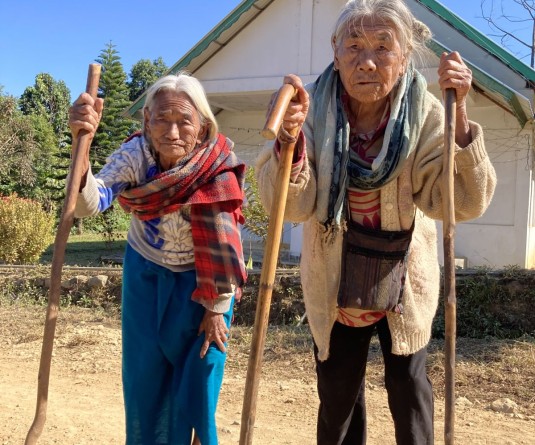
M Chuba Ao
BJP National Vice President
I have been traveling for the last few weeks between Sikkim, Arunachal Pradesh, Dimapur in Nagalandand also New Delhi. There is one common thread in all these four places that I get to hear about – its increasing heat. The so-called 'climate change' is in debate at all levels -- in middle classes households, among political karyakart as of our party, among rich and poor and even in hotels among waiters and other staff. I am not any environmental expert and hence I will be unable to suggest any scientific paper or any urgent solution.
But my observation is a man with the background of growing up in the rural areas of Nagaland amid nature. Trying to scan some articles and news-websites on the issue of 'climate change', I could discover that an abrupt change in the monsoon could precipitate a major crisis, triggering more frequent droughts. Some say there would be more floods with higher intensity in several large parts of India.
One such article says a modest 2°C rise in the world’s average temperatures will make India’s summer monsoon highly unpredictable and at 4°C warming, an extremely wet monsoon that currently has a chance of occurring only once in 100 years is projected to occur every 10 years. Means in other words, there could be devastation.
But in all the discussions I get to hear and some understanding I could make by reading articles and even some Whatsapp messages, I could find that everyone is talking about the need to grow more trees and also that the human race should depend more and more on renewable energy. This thinking process is on the right track.
But as I started to think little seriously on this issue; lost in myself, I also strongly felt that we have been unable to do much even on tree plantation. I will not speak much about urban centres and metropolis like Delhi; but in our northeastern region with wonderful greenery and people-friendly weather conditions, we need to do a lot about tree plantation. We could have done more.
To start with Nagaland, I find people confine themselves to discussions about the environment of tree plantation but will not do much. Even the occasion of World Environment Day was generally linked to 'generating funds from the central government. People also look for photo opportunities. In Nagaland including in Dimapur and especially outskirts there is no dearth of land to grow trees. But the common people's tendency has been to leave it to the government departments. This has not helped us.
As a very ordinary Ao Naga and as a BJP karyakarta, I understand that some trees are easy to grow;and perhaps it is easier to do so merely by throwing the seeds on a patch of land. Take fruits such as Lichi, jackfruit and mango. Kilos of these fruits are used by every Naga household during the season and so what can we think on this line. Simply -- throw the seeds on a patch of land and in course of time trees will come up in those places. It may sound like an oversimplification of such a huge problem but let us start like that.
We can have these at the community levels also. But most importantly, there should be 'actions' and not just rhetoric. Plantation should not be linked to drawing media publicity or a photograph on Facebook.
I include myself in this ‘doable’ category and also admit even I have not done enough of tree plantations. One article in one of the websites effect gives us a mild warning. India is already experiencing a 'warmer climate' in the last few years. The frequency of rainfall (as happens in eastern and northeastern India every June) is much less this year. Delhi is reeling under sweltering heat for the last two days.
They also say, unusual and unprecedented spells of hot weather are expected to occur far more frequently and cover much larger areas. Even the west coast and southern India are projected to shift to new and high-temperature climatic regimes. All these will have severe impacts on Indian agriculture. Moreover, many urban centres could also emerge as “heat-islands”.
In the north east, do we already have such islands in Dimapur or Guwahati? Then we must take urgent steps much more sincerely.
Now coming to the eco-friendly practices and ways to ‘save’ the planet earth; I will say our government in the centre under Shri Narendra Modi is well concerned about the issue. Prime Minister Narendra Modi has set a target to achieve 50% carbon-free energy and 100% electric vehicle usage in India by 2030.
India has progressively decoupled economic growth from greenhouse gas emissions. The massive UJALA LED bulb campaign has also helped in reducing emissions by 40 million tonnes annually, experts reported. The National Hydrogen Mission is aimed to make India the world's largest hydrogen hub.
The Net Zero Emissions target by 2030 by Indian Railways alone will reduce emissions by 60 million tonnes annually.
India’s sustained efforts have ensured that its per capita Carbon-di-oxide emissions are much lower than the global average. The US emits 14.7 tonnes per capita, China emits 7.6 tonnes per capita, while India’s CO2 (Carbon-di-oxide) emissions amount to 1.8 tonnes per capita.
My suggestion is also that we must take the people back to the fields and valleys and enforce a life closer to' good old nature friendly gestures'. The organic farming campaign of Sikkim is something we must cherish.
The Centre also supports renewable power generation through special incentives for the North East Region and Sikkim and a capital grant of Rs 22.5 million per MW is available for small hydro projects.
States like Sikkim have also created 'power policies to facilitate capital investments' to promote renewable energy. There are reasons for encouraging solar energy. Solar energy works as a dependable and sustainable energy source, fostering energy independence while enhancing access and also lowering energy prices.
It can be also pointed out that solar energy reduces dependence on non-renewable resources and decreases reliance on foreign sources of oil and gas. In some advanced states like BJP-ruled Gujarat, steps have been rightly taken for manufacturing of lithium-ion cells. Gujarat will become the first state in the country to initiate the production of lithium-ion cells.
This move helps to promote clean energy technologies and fostering the growth of the electric vehicle sector in India. All said, my basic point of emphasis is – we have so much.




